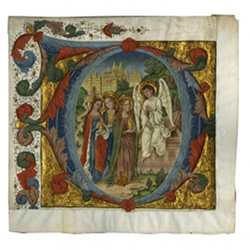
It may be hard to believe there is any commercial niche that has not been thoroughly exploited by the Internet, but the rarefied realm of high-end art has been one of those niches; at least, it had been until one company began to shed light on a part of the international art market that is not readily reachable by search engines such as Google.
MasterArt, an offshoot of an Internet services company for art dealers, has introduced a service intended to bring together dealers and collectors at prices mostly above $50,000. Would-be buyers can visit the site and search among some 15,000 works of art in any of 20 categories, such as paintings and drawings, photography, rare books, and jewelry, or they can search by an artist’s last name (for example, a recent search for works by the late Swiss painter Paul Klee revealed nine works by Klee for sale by five galleries). It is also possible to sign up to receive email alerts when a work by a specified artist becomes available.
However, MasterArt is not an e-commerce site that processes purchases online. Henry Blundell, founder of MasterArt, calls it a "connector" between buyers and sellers, who then make deals off-line the old-fashioned way. "The Internet is not yet ready for transactions, especially if prices are high," he says. "A painting can have five different colors on five different screens, so it is important to see the actual work, or at least to have a relationship with the dealer."
According to MasterArt, visitors to its website – some 30,000 a month – are mainly prominent art collectors and investors, 18% of whom have household incomes above $1 million.
Blundell says auction houses such as Sotheby’s and Christie’s do about half of all annual trade in art, and their works are well represented on the Internet via catalogs. However, he says the other half of the market (served by galleries and dealers) was not systematically visible online in 2012 when he founded MasterArt, especially at the high end.
The service has 300 registered dealers – respected galleries vetted by an expert advisory committee – who pay MasterArt an average of $4,000 each year. Blundell says he wants users to see MasterArt as a quality label, the way, for example, Zagat is for hotels. "Most markets have quality labels, but in the art market you have nothing," Blundell says. "If you want to travel to London to see the top dealers in Impressionist art, there is nothing out there that will help you do that."
MasterArt is offered by ArtSolution, an IT services company for sellers of art and antiques. ArtSolution creates and manages websites for galleries and art fairs, and manages member dealer inventories on a remote services basis. Links to these inventory databases means the works on MasterArt are updated automatically as dealers update their inventory records. That gives MasterArt an edge over other portal sites that lack such a link and whose listings, Blundell says, are often months out of date.
Alfonso Carlos L. Montero de Alba, a collector of antique military memorabilia such as medals and uniforms, says MasterArt helps him find galleries around the world that specialize in these items. "Their global reach is unique," he says. "I also enjoy the unique gatherings and dinners that MasterArt organizes with other collectors that allow me to exchange knowledge and update me on art related services."
Les Enluminures, with galleries in Chicago, New York and Paris, specializes in Medieval and Renaissance illuminated manuscripts, miniature works of art, and centuries-old finger rings. As one of just four major galleries worldwide in this market niche, it sells to private collectors, national and university libraries, and museums such as New York’s Metropolitan Museum of Art and Paris’ Louvre. Despite such august company, vice president Keegan Goepfert says all but the most knowledgeable buyers may overlook it. To broaden its exposure, especially to inexperienced buyers, the gallery recently signed up with MasterArt. "MasterArt gives us a presence in areas where we don’t normally have one," he says. He likens it to "an art fair on the Internet."
Goepfert says MasterArt provides more than basic digital content and search capability. He calls it a "forum for private collectors and major dealers and institutions." For example, MasterArt also carries listings for current events in the art world, such as fairs and gallery shows, as well as gallery publications and dealer catalogs. "I go to MasterArt because I learn a lot from scholars and other dealers that participate," he says.
Indeed, Blundell says MasterArt plans to become a more comprehensive forum for high-end collectors. "Say I need an art advisor, or an art insurance broker, or a restorer – all that is the same problem; you can’t find that information on the Internet. But we won’t be the Yellow Pages – we’ll give you three or four names, but we’ll give you the best ones." He says MasterArt.com will also offer tutorials and "webinars" to help collectors.
Blundell says the intent is to help penetrate the aura of mystery and exclusivity that surrounds art-buying at the high end of the market. "In the art market you need a friend, and if you don’t have a friend, you know nothing."
Gary Anthes is a technology writer and editor based in Arlington, VA.



Join the Discussion (0)
Become a Member or Sign In to Post a Comment